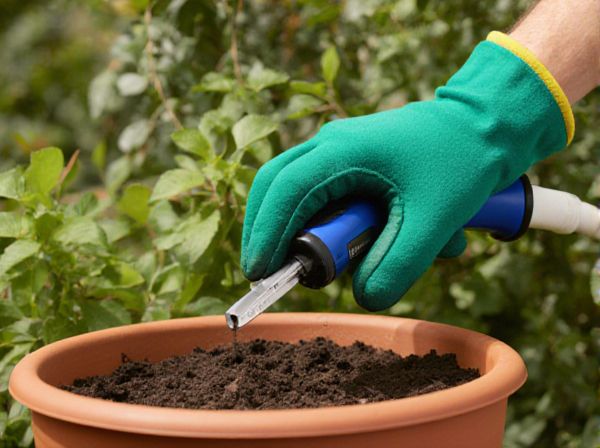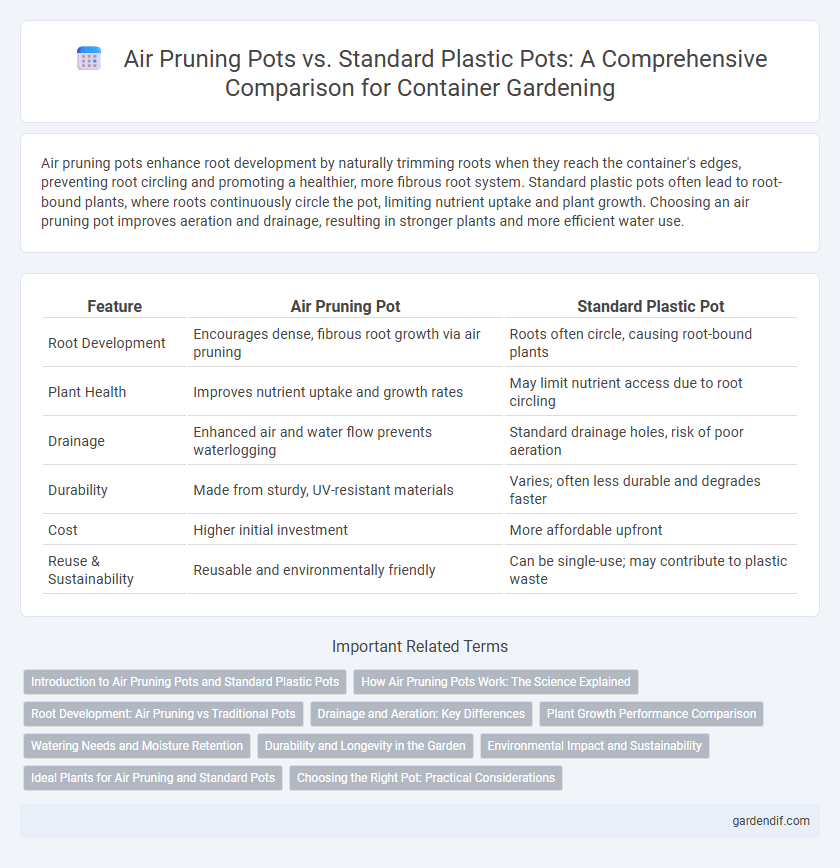
Air Pruning Pot vs Standard Plastic Pot Illustration
Air pruning pots enhance root development by naturally trimming roots when they reach the container's edges, preventing root circling and promoting a healthier, more fibrous root system. Standard plastic pots often lead to root-bound plants, where roots continuously circle the pot, limiting nutrient uptake and plant growth. Choosing an air pruning pot improves aeration and drainage, resulting in stronger plants and more efficient water use.
Table of Comparison
| Feature | Air Pruning Pot | Standard Plastic Pot |
|---|---|---|
| Root Development | Encourages dense, fibrous root growth via air pruning | Roots often circle, causing root-bound plants |
| Plant Health | Improves nutrient uptake and growth rates | May limit nutrient access due to root circling |
| Drainage | Enhanced air and water flow prevents waterlogging | Standard drainage holes, risk of poor aeration |
| Durability | Made from sturdy, UV-resistant materials | Varies; often less durable and degrades faster |
| Cost | Higher initial investment | More affordable upfront |
| Reuse & Sustainability | Reusable and environmentally friendly | Can be single-use; may contribute to plastic waste |
Introduction to Air Pruning Pots and Standard Plastic Pots
Air pruning pots feature breathable fabric walls that promote root branching by naturally air-trimming roots, leading to healthier and more robust plant growth compared to standard plastic pots with solid walls that often cause root circling. These pots enhance aeration and drainage, reducing root diseases and improving nutrient uptake, whereas standard plastic pots retain more moisture and limit air flow. Gardeners seeking improved root structure and plant vitality often prefer air pruning pots over traditional plastic containers.
How Air Pruning Pots Work: The Science Explained
Air pruning pots operate by allowing roots to reach the pot's edges where they are exposed to air, causing the root tips to dehydrate and naturally prune themselves. This process prevents root circling and stimulates the growth of a dense network of fibrous roots, enhancing nutrient and water absorption. The increased oxygen exposure around the root zone boosts overall plant health and promotes vigorous growth compared to standard plastic pots.
Root Development: Air Pruning vs Traditional Pots
Air pruning pots enhance root development by naturally trimming root tips, stimulating the growth of a dense, fibrous root system that improves nutrient and water uptake. Traditional plastic pots often lead to root circling and bound roots, which can restrict plant growth and reduce overall health. The improved root architecture in air pruning containers promotes stronger, healthier plants with better resilience in various growing conditions.
Drainage and Aeration: Key Differences
Air pruning pots feature porous walls designed to enhance drainage and aeration by allowing excess water to escape while promoting airflow to the root zone. This improved oxygen availability stimulates healthier root development compared to standard plastic pots, which often have limited drainage holes and trap moisture, potentially leading to root rot. Efficient drainage and superior aeration in air pruning pots result in robust plant growth and reduced risk of overwatering issues.
Plant Growth Performance Comparison
Air pruning pots enhance root development by encouraging natural root branching and preventing circling, leading to healthier and more vigorous plant growth than standard plastic pots. These pots enable better oxygen exchange and improved drainage, resulting in increased nutrient uptake and faster biomass accumulation. Standard plastic pots often restrict root expansion, causing root-bound conditions that can stunt overall plant growth and reduce yield potential.
Watering Needs and Moisture Retention
Air pruning pots promote better aeration and drainage, reducing water retention compared to standard plastic pots, which tend to hold moisture longer due to limited airflow. Plants in air pruning pots require more frequent watering as excess water drains quickly, preventing root rot and encouraging healthier root systems. Standard plastic pots retain moisture for extended periods, which may reduce watering frequency but increase the risk of overwatering and poor oxygen availability to roots.
Durability and Longevity in the Garden
Air pruning pots feature durable, breathable materials that prevent root circling and promote healthier root systems, resulting in longer-lasting plants. Standard plastic pots can degrade over time when exposed to sunlight and temperature fluctuations, often becoming brittle and prone to cracking. The increased airflow and robust design of air pruning pots contribute to superior longevity and sustained plant vitality in garden settings.
Environmental Impact and Sustainability
Air pruning pots enhance root health by allowing airflow and preventing root circling, reducing transplant shock and promoting vigorous growth, which leads to healthier, longer-lasting plants and less frequent repotting. These pots are typically made from recycled or biodegradable materials, lowering plastic waste compared to standard plastic pots that often contribute to landfill pollution due to limited recyclability. Choosing air pruning pots supports sustainable gardening by minimizing environmental impact through reduced resource use and improved plant vitality.
Ideal Plants for Air Pruning and Standard Pots
Air pruning pots are ideal for plants with sensitive root systems such as herbs, vegetables, and small fruit trees, promoting healthy root growth by naturally air-trimming roots and preventing circling. Standard plastic pots suit hardy, fast-growing plants like annual flowers, shrubs, and large trees where extensive root pruning is less critical. Using air pruning pots improves root density and plant health in species that benefit from enhanced oxygenation, while standard pots offer durability and cost-effectiveness for general container gardening.
Choosing the Right Pot: Practical Considerations
Air pruning pots enhance root health by naturally preventing root circling and promoting a dense root system, ideal for fast-growing plants and long-term cultivation. Standard plastic pots are cost-effective, lightweight, and widely available, suitable for short-term use or transplant starters. Practical considerations include plant species, growth duration, budget constraints, and irrigation practices to determine the most appropriate container type.
Air Pruning Pot vs Standard Plastic Pot Infographic

 gardendif.com
gardendif.com